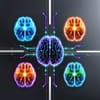A recent investigation reveals that large-language models (LLMs) appear to segregate “memory-based” and “logic-based” computations into distinct neural subsystems. According to the report, when researchers intervened in the internals of transformer-style models, they observed that components responsible for memorizing facts (for example, multiplication tables) are functionally and spatially separate from those implementing pattern-based reasoning.
One key finding was somewhat counterintuitive: tasks such as arithmetic, which many assume would invoke logical reasoning circuits, were instead disrupted when memory-regions were perturbed — whereas interfering with reasoning-region neurons had little effect on those tasks. In other words, the model seems to rely on recall of stored data rather than algorithmic deduction for arithmetic.
The broader implication is that AI architectures may benefit from explicitly modularizing memory and reasoning pathways, much like the human brain separates episodic memory (hippocampus) from procedural logic (prefrontal cortex). This separation could lead to more efficient designs, better interpretability, and perhaps fewer failure modes related to hallucination or poor generalization.
However, the study also raises challenges. If models treat arithmetic and other “logical” tasks as memory retrieval, then their ability to generalize beyond trained data or to truly “reason” in novel domains may be limited. It suggests that future work must focus on strengthening genuine reasoning pathways, and not only improving memory capacity.


